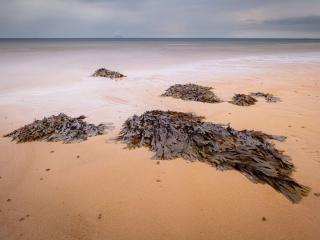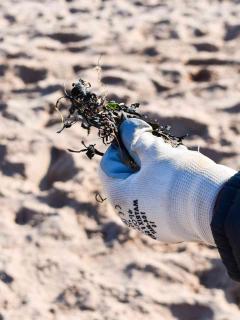

Relentlessly, with the change of seasons, waves deposit tons of seaweed of various kinds onto the sand of our beaches. This seaweed is a true gift from the sea that gardeners can take advantage of. In fact, this famous algae proves to be an excellent fertilizer to spread in the vegetable garden or flower beds. But it’s also great for mulch or as a compost ingredient.
All seaweeds deposited along the Atlantic and Pacific ocean beaches are great for garden use as long as you follow authorized collection periods and restrictions. Indeed, seaweed harvesting is often regulated by local or environmental ordinances.
Obviously, during particularly high tides, the harvest will be even more abundant. Potential treasures for the garden, brown, green and even red seaweed can be collected. Thus, on the coasts, one can easily find:
 Laminaria (or royal kelp)
Laminaria (or royal kelp)Some of these seaweeds are edible, you can include directly in your diet. Others appear in cosmetics or alternative medicine. It is also possible to recover marine eelgrass, which is not seaweed per se, but marine grasses. If you’re not lucky enough to live by the sea, don’t give up! You can also collect filamentous seaweed which gather on the edge of ponds and lakes.
All types of seaweed have high levels of iodine (except for freshwater ones) and also nitrogen, potassium, magnesium and many other trace elements like copper, boron, iron, zinc, and manganese. In the past, this seaweed was traditionally collected by residents to feed livestock and make fuel.
 First off, check that you’re allowed to harvest these sea treasures. Then, a short walk by the sea is enough to pick up (not pull out!) a few baskets of fertile kelp or wrack. This collection can be done all year round, but winter is perhaps better since this times your seaweed to be ready for spring. Days of high tides or the aftermath of storms are also an opportunity to stock up. Seaweed is easily collected with a pitchfork.
First off, check that you’re allowed to harvest these sea treasures. Then, a short walk by the sea is enough to pick up (not pull out!) a few baskets of fertile kelp or wrack. This collection can be done all year round, but winter is perhaps better since this times your seaweed to be ready for spring. Days of high tides or the aftermath of storms are also an opportunity to stock up. Seaweed is easily collected with a pitchfork.
Then, it is necessary to desalinate them before integrating them into the garden. To remove the sea salt, simply pile the seaweed onto a tarp outdoors, preferably at the lowest part of the garden. Weather will take care of removing the salt and the wind will finish drying it out. It’ll also start breaking down. Never use seaweed fresh, it takes at least two to three weeks to complete the desalination, decomposition, and drying process.
Incorporate seaweed into the soil to increase its fertility.
Gardeners can also use them as surface mulch, at the foot of rose bushes, plants and shrubs, and especially in the vegetable garden. In addition to feeding plants, they prevent weeds or invasive species from growing.
This seaweed forms a barrier against certain pests or nuisances.
It is also beneficial to incorporate it into compost.
To balance the nitrogen and potassium contributions, it is recommended to mix the seaweeds with grass clippings, manure or nettle branches.